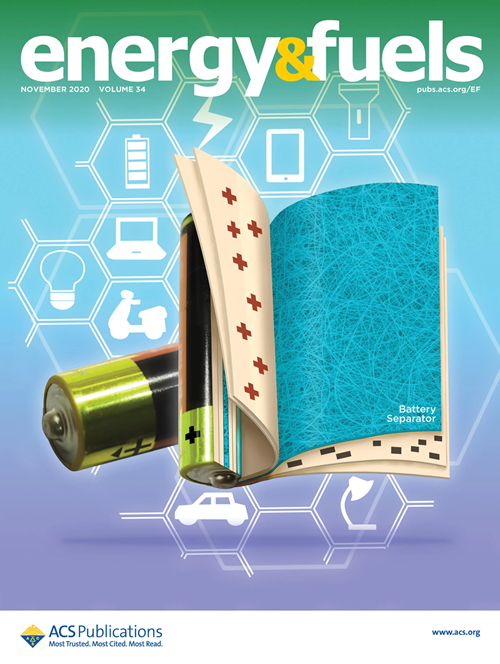脉冲磨料超临界二氧化碳射流冲击下经二氧化碳浸泡处理的砂岩的侵蚀行为
IF 5.3
3区 工程技术
Q2 ENERGY & FUELS
引用次数: 0
摘要
用二氧化碳(CO2)对水平井进行压裂的技术被认为是推进非常规油气储量和老井储量开采的一个有利替代方案。当储层岩石被二氧化碳压裂时,储层岩石的物理性质发生了很大变化。因此,当脉冲磨蚀超临界二氧化碳射流再次用于射孔时,射流的侵蚀行为也会受到岩石性质变化的影响。为了更好地匹配穿孔工艺参数,在对 PASJ 冲击下经二氧化碳浸泡处理的砂岩的侵蚀行为进行实验研究时,使用了砂岩作为目标材料。实验中对凹坑的侵蚀面积和宏观侵蚀深度进行了深入探讨。通过光学轮廓仪和扫描电子显微镜(SEM),对侵蚀坑表面的微观形态进行了细致的研究。揭示了受 PASJ 影响的砂岩的破坏模式和破坏机理。研究发现,在喷嘴压差相同的情况下,PASJ 对浸泡过的岩石样本的侵蚀能力大于未处理过的岩石样本。随着浸泡压力和浸泡温度的增加,砂岩对磨料喷射侵蚀的阻力减小,侵蚀坑的面积增大。随着喷嘴压力的升高,侵蚀坑变大,并失去了明显的锥形,这主要是由于喷射冲击的动能增加所致。光学剖面仪和扫描电镜检测表明,浸泡砂岩表面的微孔结构和孔隙率都有所增加。被二氧化碳浸泡过的砂岩内部的矿物溶质被提取出来,粗骨料暴露出来,这为随后的磨料颗粒直接破碎提供了便利。本文章由计算机程序翻译,如有差异,请以英文原文为准。

Erosion Behavior of Sandstone Treated by CO2 Soaking under Pulsed Abrasive Supercritical CO2 Jet Impact
The technique of refracturing horizontal wells with carbon dioxide (CO2) is viewed as a propitious alternative in advancing the extraction of unconventional oil and gas reserves and older well reserves. When the reservoir rock is refractured by CO2, the physical properties of the reservoir rock have changed greatly. Therefore, when the pulsed abrasive supercritical CO2 jet is used to perforate the rock again, the erosion behavior of the jet will also be influenced by these changes in the rock properties. In order to better match the perforation process parameters, sandstone was used as the target material in an experimental study on the erosion behavior of sandstone treated by CO2 soaking under PASJ impact. The pit’s erosion area and macroscopic erosion depth were both thoroughly discussed. By optical profilometry and scanning electron microscopy (SEM), the micromorphology of the erosion pits’ surfaces was meticulously investigated. The failure mode and damage mechanism of the sandstone impacted by PASJ were disclosed. It was discovered that the erosive capacity of PASJ for soaked rock samples was greater than that of the untreated rock samples under the same nozzle pressure differential. With the increase in soaking pressure and soaking temperature, the resistance of sandstone to abrasive jet erosion diminishes and the size of the erosion pit enlarges. As the nozzle pressure rises, the erosion pit becomes larger and loses its distinct cone shape, which is mainly attributed to an increase in the kinetic energy of the jet impact. The optical profile instrument and SEM inspections indicate that the complexity of the micropore structure and porosity increase on the surface of the soaked sandstone. The mineral solutes inside the sandstone soaked by carbon dioxide are extracted, and the coarse aggregate is exposed, which offers convenience for subsequent direct crushing by the abrasive particles.
求助全文
通过发布文献求助,成功后即可免费获取论文全文。
去求助
来源期刊

Energy & Fuels
工程技术-工程:化工
CiteScore
9.20
自引率
13.20%
发文量
1101
审稿时长
2.1 months
期刊介绍:
Energy & Fuels publishes reports of research in the technical area defined by the intersection of the disciplines of chemistry and chemical engineering and the application domain of non-nuclear energy and fuels. This includes research directed at the formation of, exploration for, and production of fossil fuels and biomass; the properties and structure or molecular composition of both raw fuels and refined products; the chemistry involved in the processing and utilization of fuels; fuel cells and their applications; and the analytical and instrumental techniques used in investigations of the foregoing areas.
 求助内容:
求助内容: 应助结果提醒方式:
应助结果提醒方式:


